by bria4123 on February 11, 2012
I climbed up the north tower of Amiens Cathedral’s west facade. Another man was already up there, and he looked so happy that I had to talk to him.
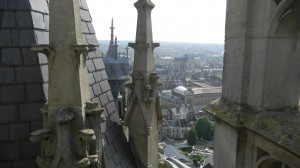
He turned out to be the director of the cathedral’s restoration, and was surveying the rest of the building from our lofty vantage point. He had come from Paris about 20 years before. “The cathedral entered me.” He moved to Amiens and never lived in Paris again.
His knowledge was impressive. He had traveled all over Europe, to many other cathedral towns, and he shares his passion by giving lectures in elementary schools.
For him, the stable order in Gothic cathedrals was more real than Paris’ urban bustle. Gothic art still strikes chords in some people in today’s digital age.
by bria4123 on February 11, 2012
Back to the West. After exploring Indian art, where better to land than one of the most influential churches in history. The abbey church of St. Denis is no less than the birth place of Gothic Style–one of the world’s greatest art forms.
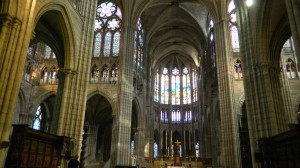
Above, you see a stunning contrast with the vast panoramas in Indian art, in which all life forms are integrated. [click to continue…]
by bria4123 on February 10, 2012
“You’re gonna do it, aren’t you, Brian!” How can I refuse when a woman asks this? We were in a group on an elephant safari in Nepal, in the lowlands next to the Indian border. A trainer just gave us an elephant riding demo. A spry man stood in front of her face, pulled her ears forward, placed his foot on her trunk and pushed. She lifted her head, and he sailed over it, turned around in mid-air, and landed with both legs around her back.
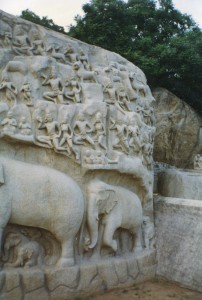
The trainer told us we could try, “But remember, you fall at your own risk.” There were 16 of us, and 3 had already gotten on top of her, so I gingerly approached her. [click to continue…]
by bria4123 on February 10, 2012
Indian art ain’t your father’s Romanesque or Gothic cathedral either.
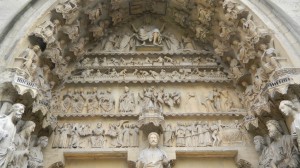
Above is a carving of the Last Judgment over a portal at Reims Cathedral.
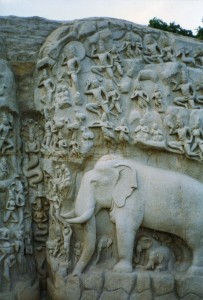
And above is Mamallapuram’s carving of the descent of the Ganges River. Both have a couple of common traits:
1. They’re of cosmic-scale events–they have important meanings for all life forms on earth and heaven–and in the first panel, a very nasty place below.
2. They’re exuberant–the guys who planned and carved these friezes enjoyed portraying as many beings as possible.
But they also reveal two different ways of seeing the world and representing reality. [click to continue…]
by bria4123 on February 9, 2012
While exploring the rock carvings at Mahabalipuram I noticed something real cool. A baby goat was scratching himself against a 1,300 year old statue of two monkeys. I loved the juxtaposition of life forms across the eras, and couldn’t resist a photo. But by the time I clicked, these kids had entered the picture.
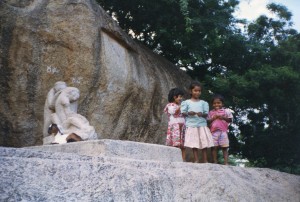
All life from antiquity to the modern age seemed unified. This experience of all these life forms close together perfectly reflected the archeological site, and Indian Art in general.
Yeah, India has its annoyances and hucksters (see Dirty Business on the Ganges), but within minutes, something always happens that either makes you laugh or warms your heart.
A Canadian woman who lived in Chennai said that your experience accelerates in India. Many Westerners miss its vibrancy when they return home.
by bria4123 on February 8, 2012
Only a few minutes passed before I was asked for money. It seemed like a reasonable request though. I had hired a man with a rowboat to take me to where the great Ganges and Yamuna rivers meet, a little outside of Allahabad, India.
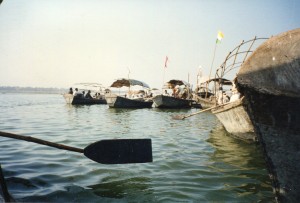
Lots of people were converging in this sacred area, and many sang religious songs and clapped hands. But soon, other boats came, with wiry young men selling cocoa nuts to offer to the river. No problem, so I paid.
But the same people descended on me when I was leaving. One jumped onto my boat, and asked for more money. I told him to get lost. He stayed and kept jabbering. I told the owner of the boat to start rowing, and the huckster jumped onto the next boat at the last second.
On the way back to the shore, I saw the same men picking the cocoa nuts out of the water with nets so they could sell them to the next batch of pilgrims.
India’s cultural landscape is one of the world’s most beautiful. Its larger-than-life stories (one of which is in a recent post on Indian art) can inspire spiritual devotion, but they also generate a lot of B.S. stories and easy credulity. Many people who pose as spiritual masters are con-artists. Lots of naive Westerners who go there for spiritual purposes get ripped off. Some women have been sexually abused by men posing as gurus.
If you approach India with a guide, be sure you can trust him.
by bria4123 on February 8, 2012
Everyone was in a fix. The ocean had been swallowed up and people had no other source of water (you can read about why this happened in Indian Art’s Love of Abundance).

The Holy Ganges River flowed across the sky, like the Milky Way. But how could it be brought down to earth? [click to continue…]
by bria4123 on February 8, 2012
“I don’t understand Indian religion. It has too many Gods.” I overheard an elderly British woman say this a year and a half ago in Oxford’s Ashmolean Museum’s section on Indian art. You can’t appreciate the depths of Indian culture through Western mindsets that want everything precisely defined, and in terms of the objects you see in front of your face.

We can overcome the bafflement some Westerners experience by exploring a story about India’s most sacred river, the Ganges. [click to continue…]
by bria4123 on February 7, 2012
The picture below sure doesn’t look like an ancient Greek temple. Nor does it look like a Romanesque cathedral. Instead of focusing on the simplest forms, this carving revels in sheer abundance.
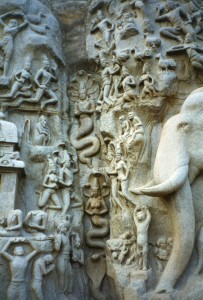
This is the middle of a 152 foot long frieze in southern India–in Mahabalipuram, 45 miles south of Chennai (it was originally called Mamallapuram, meaning city of the great wrestler). The kings of the Pallava state commissioned these carvings in the 7th century, and used them as statements of political and spiritual unity. But this unity was expressed with very different aesthetics than Greek temples’ and Romanesque art’s. What the heck is going on in that crowded scene? [click to continue…]
by bria4123 on February 6, 2012
Is any place on earth more beautiful than the Rhine on a sunny day? Before young Ludwig van Beethoven moved on to bigger places (Cologne and Vienna), and before he lost his hearing, he played by these shores.
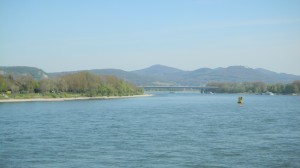
Beethoven began to lose his hearing around the age of 30–he first noticed a hum in his ears. He saw many doctors and quacks, but his affliction kept getting worse. This is the cruelest thing imaginable for one of the greatest musical geniuses in world history.
Beethoven wrote some of his most famous works when he realized that his hearing wasn’t going to improve, including his 3rd and 5th symphonies. Music lovers are astounded that they end triumphantly after earlier sections that are stormy.
It’s always dangerous to guess about the inner head of a genius. But I wonder if happy memories of the Rhine and the mountains beyond imprinted a positive view of life on him. Maybe these memories gave him hope. Listen to his 20th piano sonata–the despair in the 2nd movement suddenly transforms into the victorious 3rd, as though God suddenly lifted him up.











